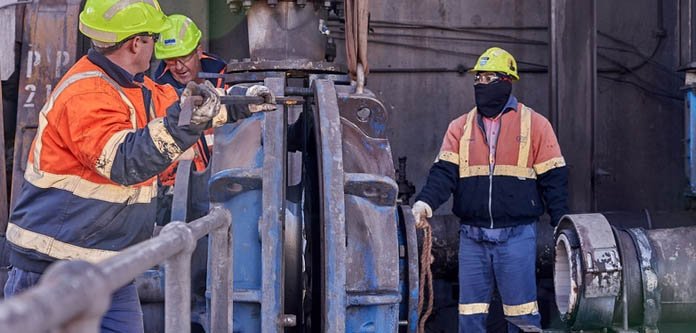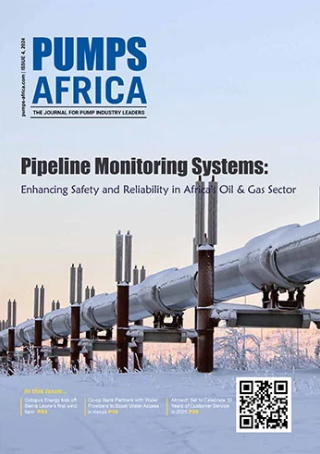Weir Minerals has made available alternative options to tackle maintenance of a slurry pump, which minimises downtime through the use of ready-to-install components.
While there are many options available to operators, choosing the right slurry pump maintenance strategy for a mine site requires careful consideration. The most commonly used method is in-situ, which involves the service team taking the slurry pump apart there and then. Weir Minerals explores the key benefits of different strategies for maintaining slurry pumps.
Below are five ways to maintain Warman® pumps.
In-Situ Maintenance
The most common strategy is in-situ maintenance, where repairs are made and worn out components are exchanged right there on the spot. As maintenance generally involves replacing key wear components within a Warman® pump’s wet end, in-situ maintenance often requires maintenance fitters to disassemble and subsequently reassemble the entire wet-end.
READ: Weir Minerals Africa unveils MCR 450 pump
This flexible approach is favoured for its lower initial cost, but is time and resource consuming during a shutdown, occupying lifting equipment and specialist maintenance fitters for up to 24 hours, depending on the work required and the pump’s size. This process also involves extensive direct man to equipment interface time.
Clamshell Maintenance
Compared to performing in-situ repairs, clamshell maintenance is significantly faster. Instead of disassembling a Warman® pump and replacing each component, the entire wet-end, or clamshell, is exchanged with a spare from storage.
This replacement significantly reduces the time of in-situ maintenance, freeing up vital cranes and personnel to work elsewhere during the shutdown, and reducing the impact of any unplanned maintenance required.
By simply exchanging the entire wet end of the pump on site, this method improves safety by minimising the direct interface between people and pump.
Following the shutdown, the removed clamshell can be safely refurbished in a more-controlled environment, leading to a higher quality rebuild in many cases.
RELATED: Maintenance tips for slurry pumps
Clamshell maintenance doesn’t consume any additional parts when compared to in-situ, although it does entail a larger initial investment to acquire the second suction cover, cover plate and frame plate which comprise a clamshell.
Bare shaft pump changeout
Similar to clamshell maintenance, bare shaft pump changes out the entire Warman® pump with a pre-prepared spare.
This shares the same advantages as clamshell maintenance, taking significantly less time to remove than in-situ maintenance, freeing up lifting equipment for other maintenance and minimising the potential for injuries and complications that in-situ maintenance can entail.
Bare shaft pump changeout does require extra capital investment, although that can be relatively modest when compared to the productivity gains from reduced periods of downtime compared to in-situ repairs. Similar to clamshell changeout, following the shutdown, the removed pump can be safely refurbished in a more-controlled environment.
As with other strategies, the application will determine whether the extra CAPEX is offset by OPEX reductions.
Back Pull Out (B.P.O.)
Some pumps are designed for the rotating assembly to be pulled out of the overall pump casing – enabling in-situ repairs of the bearings and other internal components without disconnecting the pump from its piping. These can also have spacer sleeves attached to shaft coupling, enabling the removal of the rotating assembly without shifting the motor off the pump foundation.
ALSO READ: Understanding features and benefits of slurry pumps in dewatering
In cases where only the rotating assembly requires maintenance, B.P.O. can substantially cut down the time required to perform in-situ repairs and refurbishment, although as most key wear components are located within the wet-end, it’s unusual for only the mechanical end to require work.
This maintenance strategy is ideal in clear waste water applications. In the waste water industry “ragging”, where debris becomes entangled around the impeller is a common maintenance problem B.P.O. makes it easy to access the impeller and remove the debris in these situations.
The last three options require ready-to-install components, a spare wet end or bear shaft, but makes maintenance safer and significantly quicker, restoring productivity faster or freeing up vital personnel and equipment during a shutdown.
Stand-by equipment
When performance is critical to operations, there’s no substitute for a stand-by pump. While it does increase the upfront cost of the solution and occupies additional space, the ability to switch rapidly to a stand-by in case of a duty pump failing can save tens of thousands of dollars in applications where an unplanned shutdown needs to be avoided.
Most stand-by pumps can become operational in a number of minutes, while more complex installations may require an hour or more to make the switch. Once the switch is made, engineers can repair the duty pump in-situ more safely at a less pressured pace.







